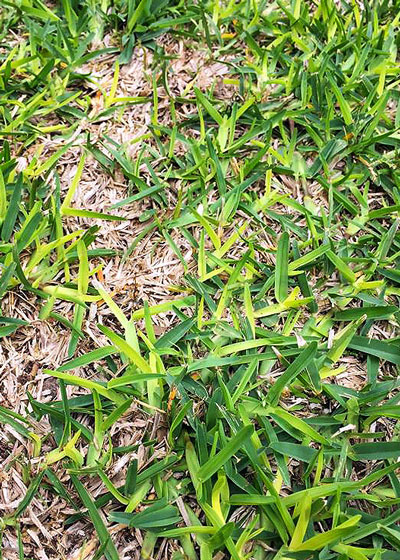A Tune Up on Take All

I first became aware of take all root rot (TARR) in St. Augustine turf in the 1990s. I was getting calls about the same time I was experiencing issues with my own lawn.
What I was seeing…
• The grass was failing to green up uniformly in the spring in spite of my following recommended management practices.
• My lawn was developing “washes” of yellowed grass spreading across it in both sun and shade in March, April, and early May. As it turned hot, the problem seemed to go away.
• When I pulled on the runners, the yellowed ones came loose easily from the soil. Their roots were short, very dark, and very stiff. It reminded me of the days of damage by white grub worms as they devoured roots of our lawns. But this time I was finding no grubs present.
• When my friend Dr. Phil Colbaugh, retired plant pathologist with the Texas Agricultural Extension Service, examined samples, he could see the small, gray hyphopodia of the fungus that causes the disease on the undersides of the infected stolons. He told my listeners and readers that they, too, could see those with just a hand lens, and that they would confirm presence of take all root rot.
• Dr. Colbaugh did some of the earliest research on controlling this disease. He found that applying a layer of acidic organic matter on top of the soil would help greatly. He ended up recommending sphagnum Canadian peat moss. That did help greatly for a couple of years, but it was quite laborious – and expensive.
• Several years ago, Phil came back to tell us that the fungicide Azoxystrobin had done a better job of actually eliminating the fungus, whereas the peat had only suppressed it. We had progress.
So, that’s what I knew as I plunged back online to see what other information southern universities now offer to home and commercial turf growers. Here are specifics I found that go beyond what I’ve just told you.

From Alabama Extension:
https://www.aces.edu/blog/topics/lawn-garden/take-all-root-rot-on-st-augustinegrass/
• St. Augustine cultivars seem to have no differences in resistance to this disease. It hits them all.
• It is found in all soil types, from coastal sands to heavy clays.
• May be linked to a deficiency in availability of the soil mineral manganese. A soil pH of 5.5 to 6.0 would be ideal.
• Recovery of TARR-damaged St. Augustine can be difficult. Laying new sod over areas where TARR has been a problem will likely result in failures. You may have to renovate the soil entirely.
• Other species of grass are also susceptible.
From North Carolina State University Extension:
https://content.ces.ncsu.edu/take-all-root-rot-in-turf
Written primarily for golf course professionals, this addresses TARR on putting greens. However, it does acknowledge that the fungus does attack other bermudas at other seasons.
Cultural suggestions are given, but mostly for golf greens. Control measures refer to commercial products including Heritage, the professional grade of Azoxystrobin.

From The University of Florida Extension:
https://edis.ifas.ufl.edu/publication/lh079
There is good information in this bulletin. (It also addresses “bermudagrass decline.”) Here are some of the highlights.
• This is a root disease, not one of the leaves or stolons (runners). By the time you can see the symptoms in the leaves, the roots will have suffered serious dieback.
• Therefore, if you have had TARR in prior seasons, Azoxystrobin should be applied as a preventive, not as an attempt at a control. I’m glad to see that statement. I have not been hammering that home enough. Now I will.
• This disease shows up worst on stressed grass. Mow regularly at the recommended height. Water properly. Avoid nitrate fertilizers whenever possible. (Several states’ fact sheets mentioned that.) Use a fertilizer with 30 to 40 percent of its nitrogen in slow-release form. Potassium (third number of the analysis) is important in helping your grass fight off the impact of the fungus.
• Grass impacted by TARR may not have the “root power” to take up minerals from the fertilizers you apply to the soil. You might try foliar feeding with a liquid food frequently as you try to nurse the grass back to health.
• Limit weedkiller application to St. Augustine to essential spot treatments only. Herbicides weaken St. Augustine and leave it more vulnerable to TARR infection.
Texas A&M AgriLife Extension
https://agrilifelearn.tamu.edu/s/product/takeall-root-rot/01t4x000004OfrfAAC
This publication shows you TARR and the other maladies you might confuse with it. It has a great deal of good information including a list of several consumer fungicides you could use.
However, to get this fact sheet you have to do more than just click into a link. For whatever their reason, TAMU requires you to go to their “bookstore” online and register. The fact sheet is free, but they seem to need to track numbers and counties (probably for our legislators), so you’ll have to give them 15 seconds of information before they’ll send you a link to the publication.
